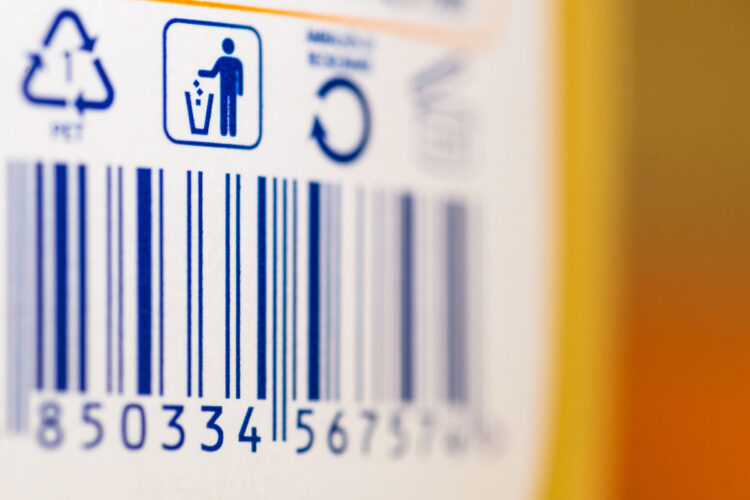Reid Lifset, a longtime member of the faculty at the Yale School of the Environment, wrote the first peer-reviewed academic article on extended producer responsibility in 1993. He’s “been intrigued by it and studying it ever since.” In an interview with Resource Recycling, he talked about his latest research article on eco-modulation and his thoughts on best practices for using eco-modulation to drive eco-design in packaging.
Eco-modulation is a layer added to some EPR programs. In the context of packaging, eco-modulation means reducing the fees that brands have to pay to the producer responsibility organization (PRO) if those brands make design choices that are beneficial to the environment, such as using recycled content or making packaging easily recyclable. On the other side of the coin, eco-modulation means increased fees for brands that make packaging less recyclable. Design that is friendly to recycling or the environment is called “eco-design.”
These are some of the latest buzzwords in the EPR realm, which has seen significant activity lately. California, Colorado, Maine and Oregon all passed EPR laws for packaging within the last several years, while other states tried and failed this year. EPR for other materials, such as household hazardous waste, tires and fuel canisters has also been recently enacted.
The following interview has been edited for length and clarity.
Resource Recycling: When did eco-modulation and eco-design enter the EPR conversation and how have they evolved?
Lifset: Back in ancient times – in the early 90s – when EPR got started, it was thought that because producers would have to be responsible for their products and packaging when they became waste, they would cost-minimize, and in doing so be drawn to engage in eco-design. It didn’t turn out that way because from the beginning, producers banded together to form what are essentially consortia – what we now call producer responsibility organizations – in order to manage their compliance with EPR requirements to get the collection and processing done.

One of the things that happened was the PROs had to figure out how to charge the producers that were their members or their clients for those services. What they typically did was to take the total cost for the management in a given category of product or package and allocate it by market share. So if, say, Lenovo has 30% of the market share for the relevant product category, then it pays 30% of the cost of managing that type of e-waste. The problem is that if Lenovo invests in making its laptops significantly more recyclable but still has a 30% market share, the fees don’t change. The result is that the financial incentives for eco-design were muted.
The story, of course, is more complicated than that, but that’s the core of it. There was always hope that there would be eco-design driven by EPR, but over the years it doesn’t seem to have happened. It’s also complicated by the fact that it’s incredibly difficult to tie EPR to specific results. For example, if a company significantly lightweights its packaging, it could be doing so to reduce its EPR fees, to save on material costs or for reputational purposes. Distinguishing between those drivers is pretty tough to do. Nonetheless, as far as could be estimated, there was little impact on eco-design. Eco-modulation emerged as a way to revive the possibility of eco-design.
“There was always hope that there would be eco-design driven by EPR, but over the years it doesn’t seem to have happened.” –Reid Lifset
Walk me through your latest research article. Why did you choose to research how to restore incentives of eco-design through eco-modulation?
I was an early proponent of EPR, and then I was disappointed when it emerged that there weren’t strong incentives for eco-design. When eco-modulation emerged, it was natural for me to say, “Oh, this is worth looking at.” I wanted to know about this new component to EPR and I started taking a deep dive. What I found was that, like everything that we want to do in the environmental world or other policy areas, it’s complicated. It doesn’t work as simply as the proponents or opponents say it does – or doesn’t – and this is, unfortunately, par for the course in many policy debates. I think that we’re not doing our homework. There’s just not a lot of careful thought being put into the assumptions underlying eco-modulation, the expected environmental results beyond recycling rates and what barriers must be overcome if it’s to work.
What are some of those barriers?
One of the unfortunate and universal problems in EPR and recycling more generally is that the data either don’t exist, or they’re really terrible. The worst cases are the governments that count success only by the number of programs that exist. Well, that’s great, but we don’t know if it got us either the operational outcomes or reduction in environmental impacts we seek. Then there are places that monitor in the sense that they keep track of recycling rates. It’s a step up, but the problem there is it still doesn’t tell us whether it’s actually EPR that’s making things happen. It just tells us that recycling went up or down. It could have been commodity prices, COVID or a myriad of different factors. Just tracking recycling rates doesn’t tell us what we need to know about the effectiveness of the policy. This isn’t a problem that’s restricted to EPR or eco-modulation. There’s just very little of what an academic or an evaluation specialist would call “ex post” evaluation, meaning evaluating the program after it’s running, which is not the same as counting recycling rates.
“Eco-modulation emerged as a way to revive the possibility of eco-design.” –Reid Lifset
The other problem also extends beyond EPR and eco-modulation. Recycling is a means to an end, as is circularity. What we want is to reduce greenhouse gas emissions or lower air and water pollution, and we recycle because we want to use recovered materials for manufacturing because it lowers energy use and air pollution. However, the endpoint measured almost everywhere is the recycling rate. Nobody says, “How much did we reduce greenhouse gasses?” And that’s true for eco-modulation as well. If we are to use eco-modulation, we should collect the right data, we should do the right analysis and find out, “Did we get something out of this?”
There’s another piece here: Eco-modulation is based on the premise that producers are going to respond to the opportunity to reduce costs. In eco-modulation, producers either get a bonus, which is actually a discount on their EPR fees, or they’ll get a penalty, which is an additional fee that they must pay. The question is: Are these fees and bonuses big enough to matter? And in some cases, they’re ridiculously small in terms of changing consumer purchasing behavior. And if every government sets up a different kind of eco-modulation program, then the market signals will be weak because if a producer responds to the requirements in one jurisdiction, but the requirements are different in another one, the producers are not likely to respond to both, or maybe they’re just going to throw their hands up. It isn’t that eco-modulation is a bad idea, it’s that we’re not doing our homework. We’re not working this through and saying, “What’s this going to get us? Does our implementation align with the expected results? And how are we going to know if we achieved our desired environmental goals?”
How do you use it effectively and restore those incentives?
I would say that you do two things. One is collect all data that’s needed to conduct an effective evaluation. The other is take it a step at a time. Do some eco-modulation with built-in plans for ex post analysis so that there’s actually a concrete path for learning what works and what doesn’t.
Going back to the environmental side of this, figuring out what’s actually environmentally beneficial is complicated. Part of what we need to do is move beyond just looking at recycling rates. That implies using [life cycle analysis] and that’s not easy. LCA carries with it its own multiple complications. It’s not simply a matter of, “Oh, we’ve got a tool, we’re just not using it. If we use it, we’ll know the answer.” Because of the limits of LCA, that won’t work. But if we use LCA to push the conversation forward and say, “I’m not automatically just going to look at recycling rates and end the conversation there. But oh, these LCAs suggest – they don’t tell you for sure, but they suggest – that we’re not getting a real good bang for the buck here, we need to look more carefully.”
Are there places using LCAs like that?
I’m a great fan of what Oregon is doing because first of all, to my knowledge, I don’t think there’s any other government in the world that’s actually requiring LCAs in conjunction with eco-modulation. The European Union talks a lot about having life cycle-based policy, but they actually don’t do it as far as I can tell. Oregon is also avoiding a nasty mistake, which is setting the actual quantitative targets for eco-modulation on the basis of the outcome of an LCA. Doing so would run into some serious methodological problems. It’s a mistake to conduct an LCA, and if the result is that the emission reduction from the policy is five times bigger than business as usual, decide to make the fees five times bigger. LCA doesn’t provide the precision that warrants that. … Oregon instead is doing something smart, they’re working to get people used to thinking about issues on a life cycle basis through the use of LCA. They are avoiding the use of LCAs as a formula for regulation, but instead using it to get people to pay attention to the environmental dimensions of our policies and goals. I think that’s exactly right. It’s really innovative, difficult and very impressive.
“If every government sets up a different kind of eco-modulation program, then the market signals will be weak.” –Reid Lifset
How does the e-commerce issue play into all of this?
Online platforms like Amazon and its competitors have an impact on the compliance with requirements for EPR and eco-modulation. Roughly speaking, there are two kinds of sellers on the platforms. Amazon itself sells its own products, and it also sells other companies’ products which in the lingo are “third-party sellers.” For any product that a consumer buys when the consumer lives in a jurisdiction that has EPR, the producer should be paying the fees to the relevant PRO for meeting all the EPR requirements, or organizing its own compliance. To my knowledge, there’s not really a problem with Amazon’s own products, because Amazon is so visible, it’s easy to find out if they’re complying.
Imagine, however, you’re sitting in Eugene, Oregon and you buy some kind of electronic product from a producer in China through Amazon. The Chinese company is a third-party seller and Oregon has EPR for e-waste, so the producer should be paying some fees to the relevant PRO in Oregon. The problem is that that’s really hard to monitor because the Chinese company may have no legal or commercial presence in Oregon. So that means at the level of EPR – not even considering eco-modulation – the relevant fees may not be collected, and that means the system will have less revenue to do its work. It’s also unfair to the producers that are paying. And with respect to eco-modulation, if those foreign producers – third-party sellers – aren’t engaged with the EPR system, then they’re not facing the eco-modulation bonuses and penalties and thus they’re not facing incentives for eco-design.
Have you seen any country or state that found a way to tackle that e-commerce problem?
In the European Union, which I pay a lot of attention to because they’re way ahead of us on these issues, there’s been a lot of discussion about e-commerce impacts on EPR. There’s also a very nice report on this issue by the OECD. There are several different efforts to deal with this. France has passed a law that requires Amazon to check to see that producers are meeting their EPR obligations. If not, Amazon must pay the relevant EPR fee and collect it from the producers. In Germany, producers selling through Amazon must verify that they have registered with the relevant EPR system. Amazon must suspend the listing of non-compliant products on the platform.
“I think that EPR has been successful in building up recycling systems and improving recycling rates. The tough questions are what is the magnitude of the environmental benefit and is it cost-effective?” –Reid Lifset
What has it been like to watch the EPR landscape grow and change?
Interesting. I’ve been disappointed about the eco-design side, so I was encouraged to see eco-modulation emerge. I’ve always been frustrated by the lack of careful analysis throughout the evolution of EPR. I think that EPR has been successful in building up recycling systems and improving recycling rates. The tough questions are what is the magnitude of the environmental benefit and is it cost-effective? I’m not saying EPR isn’t producing the benefits we seek and I’m not saying it is. I’m saying there just isn’t enough rigorous analysis. That’s not surprising as it takes time, money and expertise.
What’s your next research topic? What are you diving into next?
I have accumulated a massive amount of studies and reports on EPR. I put them into a reference database and so I have a bibliography on steroids – more than 1,200 references. I’m trying to make that available on the web, but I’ve got some work to do. I’ve got to find some funders, because some software development is needed to make this work well. I’d really like to get this out there because I have reports and journal articles going back to the very beginning of EPR, and the collection is compiled in a way that doesn’t exist anywhere else in the world. I’m also continuing to do some work on eco-modulation.
A version of this story appeared in Resource Recycling on Aug. 2.


























